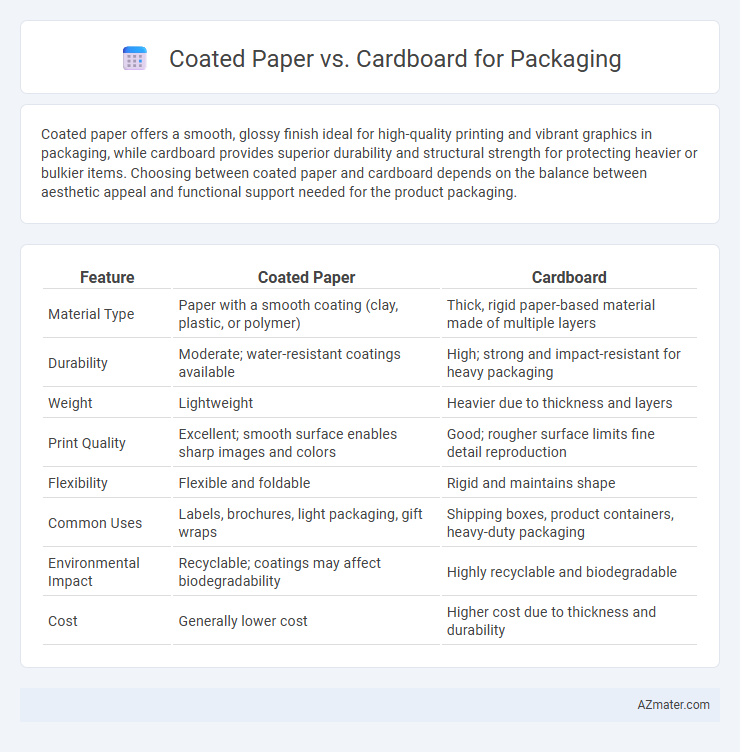Coated paper offers a smooth, glossy finish ideal for high-quality printing and vibrant graphics in packaging, while cardboard provides superior durability and structural strength for protecting heavier or bulkier items. Choosing between coated paper and cardboard depends on the balance between aesthetic appeal and functional support needed for the product packaging.
Table of Comparison
| Feature | Coated Paper | Cardboard |
|---|---|---|
| Material Type | Paper with a smooth coating (clay, plastic, or polymer) | Thick, rigid paper-based material made of multiple layers |
| Durability | Moderate; water-resistant coatings available | High; strong and impact-resistant for heavy packaging |
| Weight | Lightweight | Heavier due to thickness and layers |
| Print Quality | Excellent; smooth surface enables sharp images and colors | Good; rougher surface limits fine detail reproduction |
| Flexibility | Flexible and foldable | Rigid and maintains shape |
| Common Uses | Labels, brochures, light packaging, gift wraps | Shipping boxes, product containers, heavy-duty packaging |
| Environmental Impact | Recyclable; coatings may affect biodegradability | Highly recyclable and biodegradable |
| Cost | Generally lower cost | Higher cost due to thickness and durability |
Introduction to Coated Paper and Cardboard
Coated paper features a smooth surface enhanced by a layer of clay or polymer, offering excellent print quality and moisture resistance, making it ideal for high-end packaging and labels. Cardboard, made from compressed cellulose fibers, provides sturdy, lightweight, and recyclable packaging solutions commonly used for shipping boxes and protective packaging. Both materials serve distinct roles in packaging, with coated paper focusing on visual appeal and surface protection, while cardboard emphasizes structural strength and durability.
Material Composition and Manufacturing
Coated paper consists of a paper base layered with a surface coating of materials such as clay or latex to enhance smoothness, gloss, and printability, primarily used for lightweight packaging and high-quality graphic presentation. Cardboard, typically made from multiple layers of kraft or recycled paper pulp bonded together through a pressing and gluing process, offers increased rigidity and cushioning ideal for structural packaging and shipping protection. The manufacturing of coated paper involves processes like coating application, drying, and calendaring, whereas cardboard production relies on corrugation or lamination to achieve strength and durability parameters tailored to packaging specifications.
Surface Finish and Appearance
Coated paper offers a smooth, glossy, or matte surface finish that enhances print clarity and color vibrancy, making it ideal for high-quality packaging visuals. Cardboard typically has a more textured, matte finish with a natural or recycled look that supports structural durability but may limit detailed graphic presentation. Surface appearance in coated paper emphasizes elegance and premium branding, while cardboard prioritizes strength and eco-friendly aesthetics.
Strength and Durability Comparison
Coated paper offers a smooth surface that enhances print quality but generally lacks the structural strength and durability needed for heavy or bulky packaging applications. Cardboard, particularly corrugated types, provides superior strength and impact resistance due to its fluted core design, making it ideal for protecting goods during shipping and handling. The durability of cardboard ensures better resistance to crushing, moisture, and wear, outperforming coated paper in maintaining package integrity under stress.
Printability and Customization Options
Coated paper offers superior printability due to its smooth surface, enhancing color vibrancy and sharp detail for high-quality packaging designs. Cardboard provides more versatile customization options, including embossing, debossing, and die-cutting, suitable for sturdy packaging needs. Both materials support various printing techniques, but coated paper excels in detailed graphics while cardboard ensures structural customization.
Protection and Barrier Properties
Coated paper offers superior barrier properties against moisture, grease, and odors, making it ideal for protecting sensitive products in packaging. Cardboard provides enhanced structural strength and impact resistance, ensuring better protection against physical damage during handling and transportation. Combining coated paper with cardboard can optimize packaging by delivering both effective barrier protection and robust durability.
Environmental Impact and Recyclability
Coated paper offers a smooth, glossy finish ideal for high-quality printing but often contains plastic or clay layers that hinder recyclability and increase environmental impact due to chemical treatments. Cardboard, especially corrugated varieties, is more environmentally friendly as it is typically made from recycled fibers, biodegradable, and widely accepted in recycling programs, resulting in a lower carbon footprint and enhanced sustainability. Choosing cardboard packaging supports circular economy practices by promoting reuse and easier recycling, whereas coated paper requires specialized processing that can limit its eco-friendly advantages.
Cost Considerations for Packaging
Coated paper offers a cost-effective solution for lightweight packaging needs due to its lower material and printing expenses compared to cardboard. Cardboard, while generally more expensive, provides superior durability and protection, justifying higher costs in packaging heavy or fragile items. Companies must balance the initial cost savings of coated paper against the long-term value of cardboard's robustness to optimize packaging budgets effectively.
Industry-Specific Applications
Coated paper excels in high-quality, visually appealing packaging for the cosmetics and luxury food industries due to its smooth finish and print clarity. Cardboard is preferred in e-commerce and heavy goods sectors for its superior strength, durability, and protective properties. Both materials are integral to supply chains, where coated paper enhances brand presentation while cardboard ensures product safety during shipping and handling.
Choosing the Right Material for Packaging Needs
Coated paper offers a smooth surface with superior print quality and moisture resistance, making it ideal for high-end product packaging that requires vibrant graphics and protection from light moisture. Cardboard provides greater structural strength and cushioning, suited for shipping and packaging heavier or fragile items to ensure durability during transit. Selecting the right material depends on balancing visual appeal, protection needs, and cost efficiency for the specific packaging application.

Infographic: Coated paper vs Cardboard for Packaging
 azmater.com
azmater.com